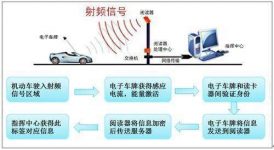
RFID technology has become an important means of building “harmonious transportation”
[ad_1]
The current increase in vehicles has become a key management and control problem for many units. In the past, guards or management offices used paper vehicle licenses for the management of frequently entering and exiting vehicles. Although this approach has the advantage of simple vehicle license production, its shortcomings are obvious, and it is impossible to realize intelligent and information-based collection. RFID technology is to bind the RFID electronic tag (unique ID) on the vehicle, and record the entry and exit of the vehicle in the database system in real time. RFID radio frequency technology uses non-contact information collection on long-distance moving targets, and the system implements automatic management by identifying the collected information. RFID technology has become an important means of building “harmonious transportation”

The characteristics and advantages of RFID technology for vehicle identification
The application of RFID technology to automatic vehicle identification has been relatively mature abroad, mainly because the characteristics of RFID technology are more suitable for automatic vehicle identification.
Anti-counterfeiting: Each RFID tag has a unique ID number in the world, and it is unmodifiable, so RFID technology has unparalleled anti-counterfeiting performance. In the RFID tag, in addition to the ID number, there is also a part of the DATA area, if necessary, some data information can be written. The vehicle number plate and license information can be encrypted and written into this area, which also has a high anti-counterfeiting feature. Through the inspection of passing vehicles by the reader, it is easy to identify vehicles with fake certificates or illegal ones.
Anti-borrowing: Since the vehicle license plate information can be encrypted and written into the label, and the information in the system database can be called, it can be distinguished whether a vehicle has the right to use the vehicle license (ie, electronic tag), thereby preventing the vehicle license The phenomenon of borrowing is to achieve the unification of the license, the vehicle or the three unification of the license, the vehicle and the driver.
Anti-theft: If a vehicle license is accidentally lost, not only can the above-mentioned methods be used to determine whether a vehicle has the right to use the vehicle license from the unity of the vehicle license number and the vehicle license, but also the vehicle license can be reported by the owner of the loss Invalidation, once a vehicle attempts to enter and exit with a lost vehicle permit, it can be identified.
Anti-disassembly: Each electronic tag is equipped with an anti-disassembly function. Once installed, the electronic tag will not work once it is disassembled, thus avoiding repeated use or other uses of the electronic tag after being removed, ensuring that the electronic tag is connected to the identified vehicle A one-to-one correspondence is formed, which serves as a true mark for electronic tags.
At present, the vehicle automatic identification system uses RFID technology of different frequency bands, including 5.8GHz, 2.45GHz and 915MHz. There are two main camps of active 2.45GHz and passive 915MHz electronic tags. 915MHz passive tags can now easily identify more than 10 meters (the distance is controllable), the technology is relatively mature, the cards are thin and diverse, easy to carry, and the cost of the card is low. It can be integrated and used with other systems; long service life, strong directionality, obvious cost advantage, good maintainability, and easy acceptance by users, which is conducive to market promotion. The sensing area is relatively controllable, and the card holder is inserted in the appropriate position of the windshield, which can fully meet the requirements of non-stop traffic. The car film will reduce the card reading distance but does not affect the normal recognition and traffic. 2.45GHz active tags are currently controlled by non-motor vehicles (electric vehicles), which can achieve positioning requirements. 2.4G active electronic tags have to replace batteries or new cards in 2-3 years. Compared with UHF, it will be cumbersome and different frequency bands. Each technology has its own advantages.
At present, the intelligent traffic management system uses a number of technologies, mainly including RFID technology, image recognition technology, data encryption technology, multi-sensor information fusion technology, computer and network technology and other international and domestic leading technical means combined with RFID electronics installed on vehicles Labels and traditional license plates are the information sources, and the system management platform and data server are the operating centers. The rapid understanding of vehicle information greatly reduces the cost of traffic inspections, improves inspection efficiency, and realizes targeted and humanized civilized traffic supervision. It is a powerful and important means to build “harmonious transportation”.
[ad_2]


